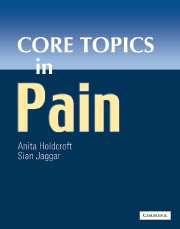Book contents
- Frontmatter
- Contents
- Contributors
- Preface
- Acknowledgements
- Foreword
- General abbreviations
- Basic science abbreviations
- PART 1 BASIC SCIENCE
- PART 2 PAIN ASSESSMENT
- Section 2a Pain measurement
- Section 2b Diagnostic strategies
- PART 3 PAIN IN THE CLINICAL SETTING
- Section 3a Clinical presentations
- Section 3b Pain syndromes
- PART 4 THE ROLE OF EVIDENCE IN PAIN MANAGEMENT
- PART 5 TREATMENT OF PAIN
- Section 5a General Principles
- Section 5b Physical treatments
- Section 5c Pharmacology
- 39 Routes, formulations and drug combinations
- 40 Opioids and codeine
- 41 Non-steroidal anti-inflammatory agents
- 42 Antidepressants, anticonvulsants, local anaesthetics, antiarrhythmics and calcium channel antagonists
- 43 Cannabinoids and other agents
- Section 5d Psychosocial
- PART 6 SUMMARIES
- Glossary
- Index
41 - Non-steroidal anti-inflammatory agents
from Section 5c - Pharmacology
Published online by Cambridge University Press: 10 December 2009
- Frontmatter
- Contents
- Contributors
- Preface
- Acknowledgements
- Foreword
- General abbreviations
- Basic science abbreviations
- PART 1 BASIC SCIENCE
- PART 2 PAIN ASSESSMENT
- Section 2a Pain measurement
- Section 2b Diagnostic strategies
- PART 3 PAIN IN THE CLINICAL SETTING
- Section 3a Clinical presentations
- Section 3b Pain syndromes
- PART 4 THE ROLE OF EVIDENCE IN PAIN MANAGEMENT
- PART 5 TREATMENT OF PAIN
- Section 5a General Principles
- Section 5b Physical treatments
- Section 5c Pharmacology
- 39 Routes, formulations and drug combinations
- 40 Opioids and codeine
- 41 Non-steroidal anti-inflammatory agents
- 42 Antidepressants, anticonvulsants, local anaesthetics, antiarrhythmics and calcium channel antagonists
- 43 Cannabinoids and other agents
- Section 5d Psychosocial
- PART 6 SUMMARIES
- Glossary
- Index
Summary
Classification
Non-steroidal anti-inflammatory drugs (NSAIDs) may be classified by chemical group or by mode of action.
Chemical groups
(a) Salicylic acids
— Acetylated (e.g. acetylsalicylic acid (aspirin)).
— Non-acetylated (e.g. diflunisal).
(b) Acetic acids
— Indoleacetic acids (e.g. indomethacin, sulindac).
— Phenylacetic acids (e.g. diclofenac).
— Pyrroleacetic acids (e.g. ketorolac).
(c) Coxibs (e.g. celecoxib, parecoxib, etoricoxib).
(d) Fenamates (e.g. mefenamic acid).
(e) Oxicams (e.g. piroxicam, meloxicam).
(f) Phenazones (e.g. dipyrone).
(g) Propionic acids (e.g. ibuprofen, naproxen).
(h) Pyrazolones (e.g. phenylbutazone).
(i) Others (e.g. paracetamol (acetaminophen)).
Mechanisms of action of anti-inflammatory analgesics
The enzyme cyclo-oxygenase (COX) catalyses the production of prostaglandins (PGs) and thromboxanes from arachidonic acid. COX exists in at least two isoforms, with a wide range of physiological activity as simplified in the Table 41.1.
When tissues are traumatised by surgery, there is a release of pro-inflammatory mediators that induce COX-2. Increased levels of the PGs formed can induce peripheral sensitisation of nociceptors, but also secondary sensitisation in the dorsal horn by blockade of the inhibitory action of glycine. This action, by induction of the gene for COX-2 protein is described further below. The role of COX-2 in the nervous system is therefore not only peripheral but also central, with COX-2 inhibitors that cross the blood—brain barrier potentially reducing central sensitisation.
- Type
- Chapter
- Information
- Core Topics in Pain , pp. 277 - 280Publisher: Cambridge University PressPrint publication year: 2005
- 1
- Cited by



